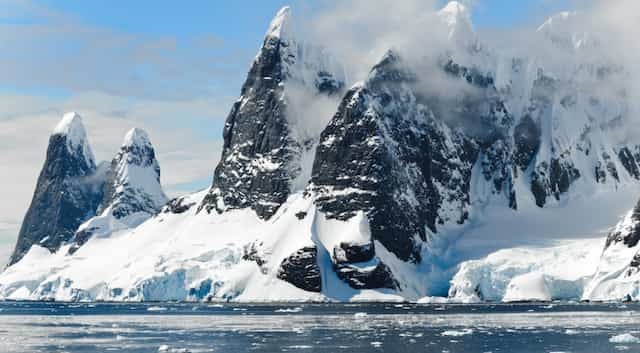Description

Disclaimer: Copyright infringement not intended.
Context
- West Antarctica’s Thwaites Glacier — often known as the “doomsday glacier” due to the potentially catastrophic consequences of its hypothetical collapse — began rapidly retreating at an earlier date than scientists had previously known, according to a study.
- The study used new satellite technology to conclude the rapid melting of the glacier likely began in the 1940s.
Details
Thwaites Glacier
Thwaites Glacier, often dubbed the "Doomsday Glacier" or the "Big One," is one of the largest and most significant glaciers in Antarctica. Here's a comprehensive note covering various aspects of Thwaites Glacier:
Location:
Thwaites Glacier is located in West Antarctica, spanning approximately 192,000 square kilometers (74,000 square miles). It is situated on the western side of the Antarctic continent, adjacent to the Amundsen Sea.
Significance
Size and Characteristics
- Thwaites Glacier is one of the widest and fastest-flowing glaciers in Antarctica, with a width of around 120 kilometers (75 miles) at its widest point. It is also extremely thick, with ice thickness exceeding 3,600 meters (11,800 feet) in some areas.
Ice Flow
- Thwaites Glacier acts as a major artery for the flow of ice from the West Antarctic Ice Sheet into the ocean. It drains an extensive portion of the West Antarctic Ice Sheet, contributing significantly to global sea-level rise.

Concerns
- Rapid Melting: In recent years, Thwaites Glacier has been experiencing accelerated melting and thinning. Studies using satellite imagery and other monitoring techniques have revealed that the glacier is losing ice at an alarming rate, particularly along its edges where it meets the ocean.
- Grounding Line Retreat: The grounding line, which marks the point where the glacier's ice transitions from resting on bedrock to floating on the ocean, has been retreating inland. This retreat destabilizes the glacier, allowing more ice to flow into the ocean and contributing to sea-level rise.
- Potential Sea-Level Rise: Thwaites Glacier holds enough ice to raise global sea levels by several feet if it were to collapse entirely. While the exact timeline and extent of potential collapse remain uncertain, scientists are closely monitoring the glacier due to its significant implications for coastal regions worldwide.
- Underlying Geology: The bedrock underlying Thwaites Glacier plays a crucial role in its stability. Recent research has revealed that the glacier sits in a deep trough, which allows warm ocean water to flow beneath it, accelerating melting and undermining its integrity.
Research Efforts
- Scientists from around the world are conducting extensive research on Thwaites Glacier to better understand its behavior and the factors driving its accelerated melting. This research involves field expeditions, satellite observations, computer modeling, and other advanced techniques.
International Collaboration
- Due to the glacier's global significance, there is a growing emphasis on international collaboration in studying and monitoring Thwaites Glacier. Initiatives such as the International Thwaites Glacier Collaboration (ITGC) bring together researchers from multiple countries to tackle the complex challenges posed by the glacier.
Climate Change Link and Recent Study
- The rapid melting of Thwaites Glacier is primarily attributed to climate change. Rising temperatures, both in the atmosphere and ocean, are driving increased ice loss and destabilization of the glacier, highlighting the urgent need for global action to mitigate climate change.
- By analyzing marine sediment cores extracted from beneath the ocean floor, researchers found the glacier began to significantly retreat in the 1940s, likely kicked off by a very strong El Niño event — a natural climate fluctuation which tends to have a warming impact.
- Since then, the glacier has been unable to recover, which may reflect the increasing impact of human-caused global warming, according to the report.
- What happens to Thwaites will have global reverberations. The glacier already contributes 4% of sea level rise as it sheds billions of tons of ice a year into the ocean. Its complete collapse could raise sea levels by more than 2 feet.
- But it also plays a vital role in the stability of the West Antarctic Ice Sheet, acting like a cork holding back the vast stretch of ice behind it. Thwaites’ collapse would undermine the stability of the ice sheet, which holds enough water to raise sea levels by at least 10 feet, causing catastrophic global flooding.

Conclusion
Thwaites Glacier is a critical component of the Antarctic ice sheet, and its rapid melting poses significant risks for global sea-level rise. Understanding the dynamics of this glacier is essential for predicting future sea-level changes and developing strategies to mitigate the impacts of climate change. Thwaites’ retreat was set off by an extreme El Niño that happened at a time when the glacier was likely already in a phase of melting, knocking it off balance
|
PRACTICE QUESTION
Elaborate upon the impact of the rising sea level on the coastal regions of India. Also, mention the measures taken by the Government of India to mitigate the repercussions of this sea-level rise. 250 words
|











